NeuroBoost – Supporting Neurologic Health and Healing
Neurologic issues can be very frustrating, and scary. For an owner watching their animal seizure, the time passing can feel like an eternity. Nerves are one of the slowest tissues to heal – and so when we look at cases where neurologic health and healing is desired, we always have to know that even in the best situations, we are often looking at months of healing time. Certainly we see immediate improvements in some cases, as we are reducing inflammation or addressing other physical issues that can repair in a faster time frame – but a damaged nerve in itself, can be as “slow as molasses in January” to heal. It is incredibly important to support any animal with a neurologic condition with the Foundation of Health, as well as to work with a veterinarian to have a better understanding of the basis for why the neurologic issue may be present.
Please do read the NeuroBalance Diffusion Blend page as well if you have an animal who is experiencing nerve related symptoms. There is a wealth of information on both pages!
If your veterinarian has diagnosed an issue such as Wobblers, Spondylosis, IVDD (Intervertebral Disc Disease), a traumatic injury, or any other form of disease that may cause a physical impingement upon a nerve structure – it is important to recognize that there is more to be concerned with than just healing nerves alone. There will be a structural, musculoskeletal component to the symptoms – that “neurologically beneficial” essential oils cannot quite deal with as a root cause. Essential oils can and do still benefit these issues – as they can help the body to remove inflammation, support the body systems in repair, improve immune system function, relieve stress and discomfort, support the surrounding muscle and tissue structures, promote death of abnormal cells (apoptosis of tumor cells), provide antibacterial and antiviral actions, and more. For nerve conditions that do have a musculoskeletal component, I like to include additional targeted essential oil use such as New Mobility, AromaBoost, or Any-Itis.
Seizures
Seizures are unfortunately common in a variety of animals, but especially in dogs. It is highly important to have a full veterinary work up and investigation if your animal has had a seizure because there are many possible causes. Epilepsy, toxin exposure, brain tumors, medication reactions, hypoglycemia, vaccinosis, liver disease – and so many other conditions can create seizures in animals. Knowing the most likely cause for the seizure can help to target specific support with holistic care. If a liver shunt or disease is present, then supporting the liver can be just important, if not more important than nerve support.
Although it is rare to completely eliminate all seizures, I do find that holistic regimens, including essential oils, greatly help animals with seizures. Most often, we will incorporate NeuroBoost with NeuroBalance Diffusion Blend for a layered approach – which we find the most beneficial with difficult health issues. NeuroBoost has been used with many animals on a variety of medications, not just those used as anticonvulsants. When used properly, we have found no need to avoid essential oils in medically managed animals.
Some essential oils have a reputation for needing to be avoided with seizures. I have found this to be quite an odd situation. Oils that have had the reputation for needing to be avoided, have certainly shown themselves to be beneficial to certain individuals, and at the very least – not harmful or encouraging to the seizures. And, in the complete opposite response, I have (very rarely) witnessed oils that would normally be indicated for those with seizures (Frankincense was an odd one I encountered in a human) – actually seem to provoke them. I would say the most accurate statement would be that I would never rule out the possibility that there will be an individual animal, for which essential oils (or any holistic treatment for that matter) seem to encourage seizures or symptoms. But, I also keep in mind that I have seen diet changes affect seizure frequency, as well as owner’s perfume, cologne, hairspray, household cleaning chemicals, topical flea and tick medications, and a large bevy of items that we may never even suspect as instigators. I encourage anyone concerned with reports of which essential oils can be used with “any condition” to read Tisserand & Young’s second edition of the book Essential Oil Safety. When you can read the true reports of why an essential oil may have been contraindicated for a condition in the past – you will gain a much clearer understanding of if the concern is valid or over-represented.
For any animal with seizures, I do start slowly when introducing essential oil use. You can decide if you wish to start with topical applications or with just diffusion. But, I will generally select just one at first, unless the animal has already been being exposed to regular diffusion and/or topical applications. In these situations, we can typically continue what has already been done. I have animal caregivers watch these animals particularly close when any change to their health regimen occurs. Pet parents of seizure animals, are usually quite dedicated to knowing how often seizures are occurring, how long they are lasting for, the severity of the seizure, and when the next one is “due” to arrive – and so changes to these details are usually easily noticed. More often than not we see some sort of benefit – whether a reduction in numbers of seizures, shortening of duration, decrease in severity, or faster recovery. As you can read about on the NeuroBalance Diffusion Blend page – there are a number of scenarios that can occur.
Vestibular Disease
This disorder often comes on suddenly with no warning. More often than not, a veterinarian will be able to find no reason for an animal (most commonly dogs, but cats can suffer with this condition as well) to all of a sudden be staggering around, walking crooked, turning in circles, and often displaying a head tilt. Basically, the animal is in full vertigo – with the Vestibular nerve being affected and the balance of the animal being completely out of whack. Deep ear infections, tumors, and trauma can cause the condition – but often times it is termed idiopathic – which means we have no idea why it is occurring.
I have seen cases severe enough (especially in cats) – that the animal would roll across the floor continually, and actually require sedation and nutritional support until the symptoms stabilized. For most animals, the condition will get better, and the animal will end up in a “compensated” state – able to walk and function. Although many may retain a head tilt for the rest of their life.
The condition happens more often in older dogs, but can happen in any animal. Rabbits also can experience a “torticollis” or head tilt due to bacterial infections. NeuroBoost and NeuroBalance Diffusion Blend are both beneficial in these animals as well.
Cognitive Dysfunction
As animals age, we can see a decline in their cognitive functions. We may see older dogs “forgetting” that they were just outside or older cats who seem to forget that they just ate – and a variety of odd behaviors that can be related to “senility”. NeuroBoost and NeuroBalance can help to support the function of the brain, calm emotions, and promote a healthier state of thoughts. The Foundation of Health is also incredibly important in this condition – and making sure that a great diet, along with TONS of hydration is provided – and especially whole food supplements like Standard Process Whole Body Support & Tuna Omegas, along with brain healthy digestive enzymes.
Cerebellar Hypoplasia
This condition is common in kittens, who were born to mothers who experienced a Parvo Virus (Feline Distemper) infection while pregnant. The kittens are affected by the virus in the womb, and their Cerebellum is not developed properly. These kittens often display “intention tremors” which is a shaking that gets worse when the cat is trying to eat or concentrate on something. These cats actually do quite well in life, but because the brain is actually underdeveloped, and not necessarily experiencing an active disease condition – it is quite unlikely that we can repair the condition. With great holistic regimens and essential oil support – the kitten is just healthier in general – which is a great benefit no matter what, and tends to minimize symptoms. But to “fix” this problem is unlikely to happen.
Equine Protozoal Myeloencephalitis (EPM)
A difficult and frustrating condition in horses, EPM often displays neurologic symptoms that end a horses riding, showing, or eventing career. AromaBoost is a fundamental recommendation – and I always make sure to incorporate the use of NeuroBoost as well. Most often, NeuroBoost will be used daily to weekly, depending on the severity of symptoms, as well as inserted into the AromaBoost when administered. A typical schedule for an EPM horse experiencing significant neurologic symptoms might be an application of AromaBoost RTU daily to every week (with NeuroBoost also applied at that time), along with NeuroBoost being applied alone every day to every 3 days. Schedules for essential oil support, are often tailored to the needs and responses of the individual horse. NeuroBoost is often applied at the top of the neck and poll area when possible.
All Other Things “Nerve”
There are situations where we may not have clear cut answers or a name to a diagnosis – but we do suspect that nerve health is affected. For all of these conditions as well as any other that affects the nerves – essential oil use is always a great idea in my opinion. Because essential oils can do so much more than “only” support nerve health – we get the added benefits of also supporting the immune system, reducing inflammation, improving emotional health, decreasing stress, and so many other beneficial properties that are carried with essential oils.
A bird who has flown into a window, a cat with Horner’s Syndrome, a dog with a lick granuloma – all have nerve involvement of one sort or another. All things function with nerves, and even pain and irritation will be communicated by the nervous system. The healthier a nervous system is, the better the body can function. Read below for the best ways to use NeuroBoost for the species you are interested in. And, make sure to see also if NeuroBalance Diffusion Blend may also be a good option for your case.
Ingredients:
Fractionated Coconut Oil, Essential Oils of Helichrysum (H. italicum), Frankincense (Boswellia carterii), Lavender (Lavandula angustifolia), Copaiba (Copaifera officinalis), Geranium (Pelargonium graveolens), Marjoram (Origanum majorana), Melissa (Melissa officinalis), Basil (Ocimum basilicum), Cypress (Cupressus sempervirens), Peppermint (Mentha piperita), Thyme (Thymus vulgaris), Oregano (Origanum vulgare), Roman Chamomile (Chamaemelum nobile), Balsam Fir (Abies balsamea), Vetiver (Vetiveria zizanioides), Nutmeg (Myristica fragrans), Black Pepper (Piper nigrum), Spruce (Picea mariana), Ylang Ylang (Cananga odorata), Vitex (Vitex agnus castus), Myrrh (Commiphora myrrha), Fennel (Foeniculum vulgare), Citronella (Cymbopogon nardus), Catnip (Nepeta cataria), Juniper (Juniperus communis), Laurus nobilis, Valerian (Valerian officinalis), German Chamomile (Matricaria recutita), Blue Yarrow (Achillea millefolium), Cedarwood (Cedrus atlantica), Clary Sage (Salvea sclarea), Spikenard (Nardostachys jatamansi)
Cats: Cats can use NeuroBoost in place of KittyBoost for extra support for neurologic conditions. Some cats may already be using our KittyBoost product – and you may want to try the NeuroBoost for them. When this is the case, I often recommend just using NeuroBoost in the same effective methods, doses, and ways that you have already been using the KittyBoost. NeuroBoost is especially indicated for those cases that may not be having enough benefits from KittyBoost alone, especially if a neurologic component to their illness may be present. Cats can usually use the NeuroBoost right out of the bottle, in the same methods as described for KittyBoost. However, for those of a more delicate nature – further dilution initially (as described above) is a wise start. If your cat is new to essential oils, follow the instructions on the KittyBoost page regarding application.
Alternating use of NeuroBoost, LiverBoost or other body supporting “boosters” can be a great way to provide all over system support on a routine basis. For example, one of my cats gets a “boost” weekly. One week I may use NeuroBoost, the following week I use LiverBoost, and then the next week I might select CardioBoost. Each time, I am supporting a body system just a little bit more specifically – good insurance for the future in my eyes. However, for one of my cats who is a breed prone to developing hypertrophic cardiomyopathy – I may select CardioBoost more often or as my main selection. NeuroBoost could be used without rotation to other formulas for animals with mainly neurologic support desired.
Dogs: Many dogs can benefit from additional neurologic support. Even if they are clinically “normal” – an occasional NeuroBoost is a great idea, and I believe preventive in nature.
For general maintenance, dogs can have an occasional application of NeuroBoost for added support of maintaining a healthy and happy neurologic system. This application can be inserted into an AromaBoost application – generally between the #3 and #4 application – although any spot is technically okay. Use whichever schedule you are using for your AromaBoost applications – and apply the same amount of drops as you would with formulas 1-5.
You can also apply NeuroBoost as a separate application unto itself – if desired. In general, 3-5 drops are applied to small dogs, around 10 pounds (4.5 kgs) and under. However, for dogs who are new to oils, or maybe more sensitive – diluting your first few applications can make applications easier on your dog.
Basically, you can just drip the oils up the back and massage in, or you may apply the drops to your hands and then apply them to your dog in a Petting manner. For larger dogs – you can usually apply more drops. For medium dogs between 25-50 pounds applying 5-8 drops is average. And for large dogs over 50 pounds – a range of 6-12 drops can be used. For dogs new to essential oils – starting with even less than the recommended amounts, or with further diluted oils can be a good way to ensure you do not create an oil aversion. You may not see results with lesser amounts, or with further diluted oils sometimes, but since we are also wanting to create a “happy” situation with oil use for your dog, and not overwhelm them – the added time to slowly build up concentrations of essential oil use can be worth it.
For dogs who have been diagnosed with a neurologic disease – it is important that you work with your veterinarian, and monitor your dog closely with their aid. Never neglect the use of veterinary diagnostics and traditional treatments when they are indicated, and make sure to tell your vet that you are using natural substances that help support nerve health and function.
For my own dogs – I often rotate through several of the body specific support blends, each time I perform their “routine maintenance”. So, if my dogs get a monthly AromaBoost RTU applied – I might insert NeuroBoost one month, then CardioBoost another month, and so on. However, for my patients who do have existing neurologic symptoms, I will strive to support their nervous system much more often, and regularly. In some cases, daily applications of NeuroBoost can be considered – but I find that every 3-7 days is average for most dogs needing additional support.
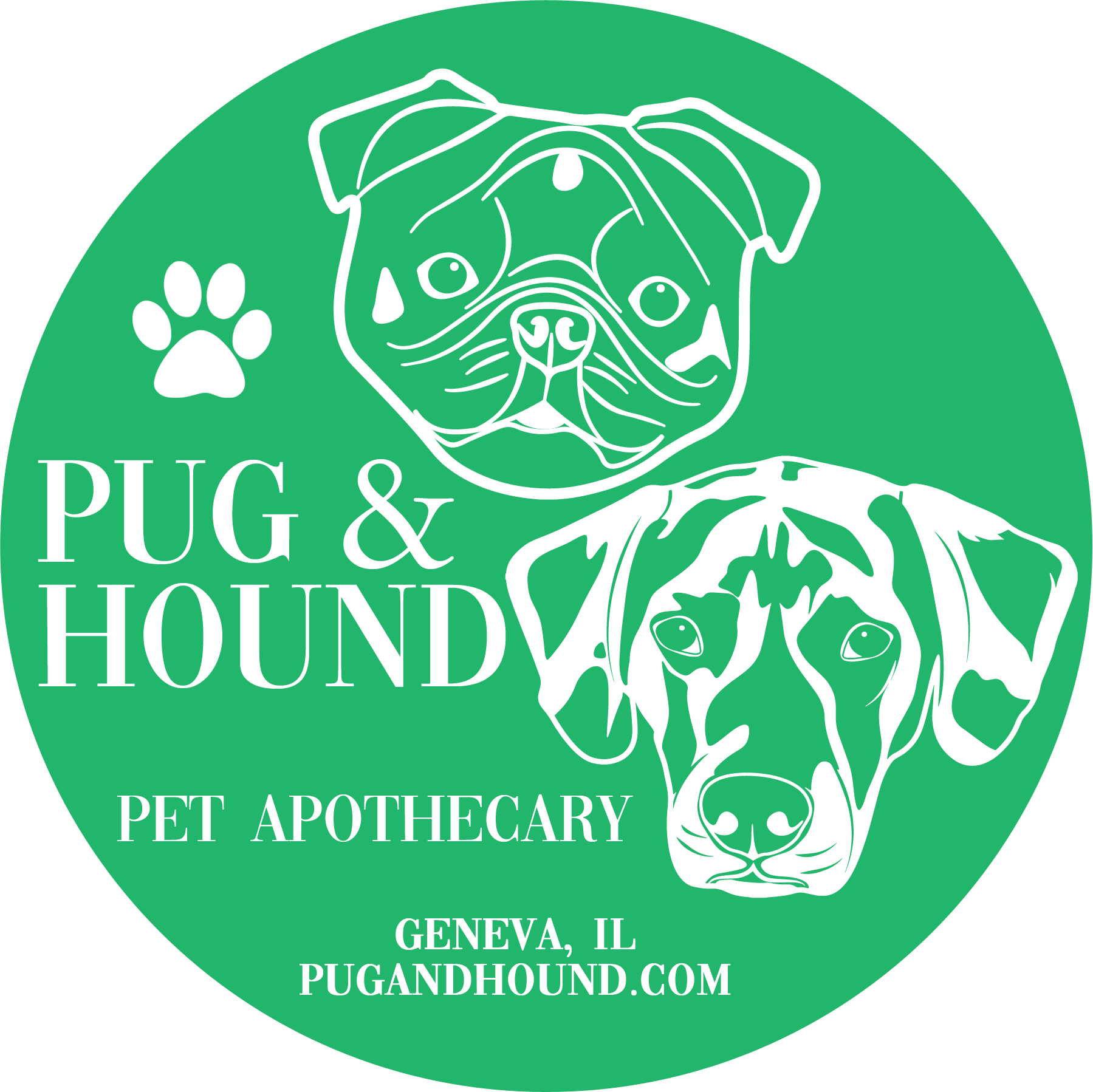
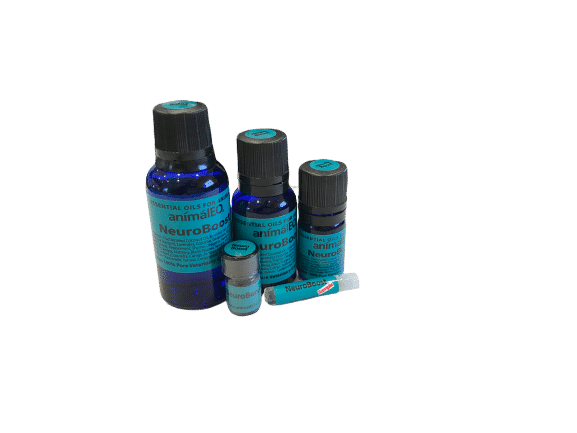
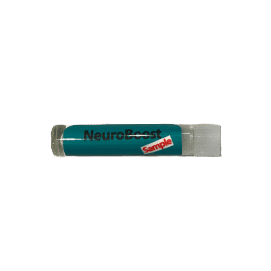
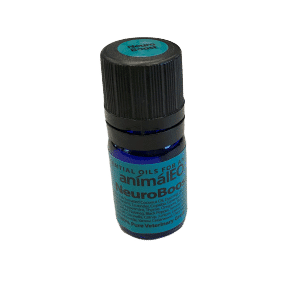
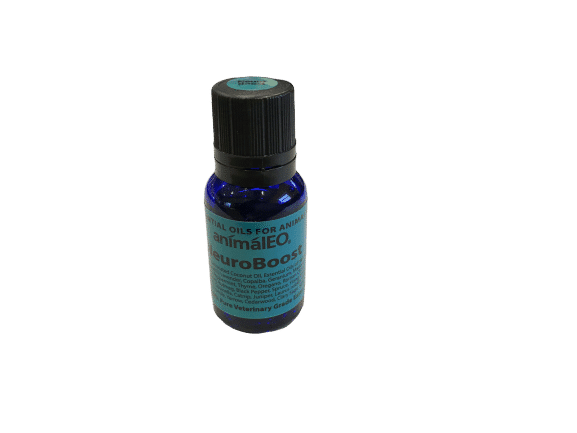
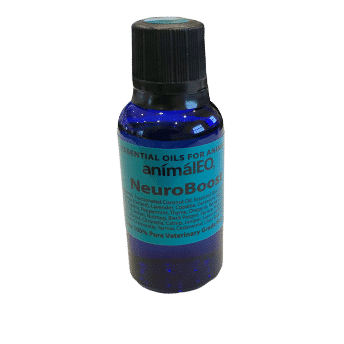
Reviews
There are no reviews yet.